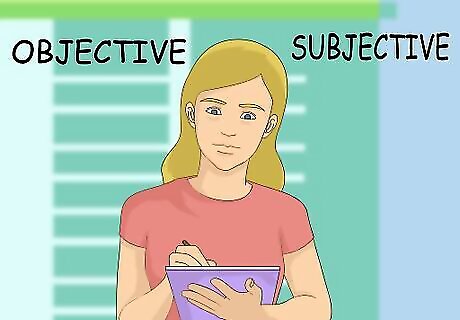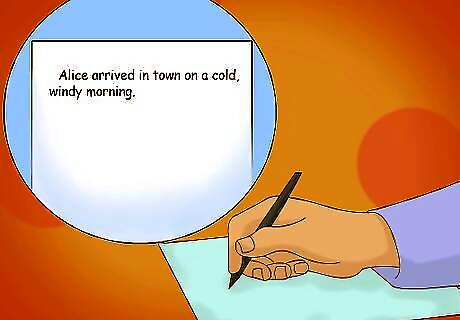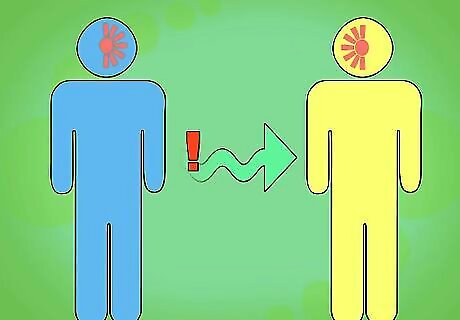
views
Understanding How This Point of View Works

Be aware of how point of view works. Any point of view, or POV, whether its first person or third person should provide the reader with insight into that character's thoughts, feelings, emotions and knowledge. Point of view should let the reader know how your character feels and thinks, as well as what they see around them, within a certain setting.
Familiarize yourself with third person perspective. When writing in the third person, use the person's name and pronouns, such as he, she, it, and they. This perspective gives the narrator freedom to tell the story from a single character's perspective. The narrator may describe the thoughts and feelings going through the character's head as they tell the story. For example, a passage written in third person might read, “Karen switched on the light in her bedroom. Immediately after she did so, a cold chill ran down her back. She stood only a few feet away from an unexpected visitor. Karen wondered if she should run or stay and fight, but it didn't really matter because she was paralyzed by fear.” Notice how this passage not only describes what Karen is doing, but also what she is thinking and feeling.

Recognize the benefits of using third person omniscient. In this POV, the narrator has access to all the thoughts and feelings of the characters in the story and is not limited to only 1 character's point of view. So as the author, you can shift from 1 character's POV to another character's POV, and the same events can be interpreted by several different character voices. Because the POV is omniscient, it has a “god like” distance from the characters and can have a bird's eye view of the events, actions, and thoughts of the characters. As the author, this POV gives you a lot of freedom to inhabit many character voices and perspectives.

Be aware of the cons of the third person omniscient. Unfortunately, being god like has its downsides. Because you are viewing your characters from above, you are also presenting them to your readers at a distance and this can lead to more telling than showing in the story. This may not allow your reader to connect as deeply with the characters and can lead to a dull or stiff narrative. Readers may feel like they are learning about characters rather than being immersed in their stories. If you are writing a more character driven story, the third person omniscient POV may not be ideal, as it does not allow you to embody 1 character's perspective in detail, including their thoughts and emotions. If your story is more plot driven and wide in scope, the third person omniscient POV may work better for you, as it allows you to move through scenes with multiple characters, as well as through time and space fairly easily, when done right. Regardless of which POV you use, you want to always ensure the reader can relate to the characters and is never lost or confused.

Keep in mind this point of view can address the reader directly. Another advantage this POV has over other POV is that as the author, you can talk directly to your reader, creating a more intimate, direct relationship with them. This could be as simple as stating, “Dear reader, it was a hard decision to kill off Alice. Let me tell you why.” Or a less direct address to the reader, such as, “Don't worry about Alice. She'll have some hard times but eventually, she'll recover and live happily ever after.”

Be aware of the 2 types of third person omniscient. This point of view can be categorized into 2 types: objective and subjective. The objective version is the “fly on the wall” POV, where the narrator is present but invisible in the story. They will relate the events as they happen, but do not offer any opinions on the events. This POV is like a camera that follows the characters around, showing their actions and dialogue, and not entering into the internal thoughts of the characters. The subjective version has a strong narrative voice that discusses the characters' internal thoughts within a scene. So all the emotions and thoughts of the characters are filtered through the narrator's voice, in their own words.
Using This Point of View

Decide which type of third person omniscient POV will benefit your story. If you are trying to explore an idea through multiple narrators, but want to show their emotions through action and dialogue, rather than internal thoughts, the objective third person omniscient POV may be right for you. If you want to write a story with a strong narrator who frames the characters with their narrative voice, the subjective third person omniscient may be a better fit for your story.

Practice writing in your chosen POV. Rather than using “I”, which is first person POV, or addressing the reader as “you”, which is second person POV, address the characters by their names or by the applicable pronoun, such as: he, she, his, hers, him and her. For example, instead of writing: “I arrived in town on a cold, windy morning,” you would write, “She arrived in town on a cold, windy morning” or “Alice arrived in town on a cold, windy morning.”

Avoid identifying the narrator with objective third person omniscient. When you write in this point of view, remember that the narrator is usually an unknown entity as it is acting as an all seeing eye. So you do not need to give the narrator a name or provide any information about them to the reader. This is different than the first and second person perspectives, where the narrator plays a starring role in the work and dominates the point of view.

Create a strong narrator to use subjective third person omniscient. The most well known example of this type of narrator is the “Lemony Snicket” character in “A Series of Unfortunate Events.” The “Lemony Snicket” narrator identifies himself as “I”, but also addresses the reader directly and shifts into different character perspectives throughout the novel.
Avoiding Common Mistakes

Stay in the POV of 1 character until you transition to another character. Not doing this can lead to a point of view breach. A POV breach occurs when a character knows something that he or she couldn't possibly know from his or her point of view. For example, even though the narrator may know that Paul hit John from behind, John won't know Paul hit him, unless he discovers this information from outside sources or by process of elimination. A POV breach can also take away from the believability of the story as a whole, and undermine the character voices you have worked so hard to create. So watch out for any breaches of point of view. Another issue that can arise is head hopping, where you hop around from 1 character's thoughts to another character's thoughts within 1 scene. Though technically a correct way to do third person omniscient POV, this technique can be confusing for the reader and lead to too many thoughts crowding up the scene. Be consistent with dialogue tags to avoid confusion. You may also need to use the characters' names if you have multiple characters of the same gender.

Use transitions to move smoothly between multiple characters. To avoid confusing your reader and head hopping around, focus on creating a bridge or smooth switch to another character in the scene.

Signal a transition before shifting to another character's perspective. Do this by drawing the reader's attention to the character and describing the actions or movements of the character in the scene. For example, if you are shifting from Paul's perspective to John's perspective, you could note: “John rubbed his lower back, where he had been hit. He noticed Paul standing beside him. Could Paul have bumped into him? John thought.”

Have a character take the lead in the action. This is a good way to transition to a new viewpoint. Once the new character takes the lead in the action, continue into his or her thoughts or feelings. For example: “John slammed his drink down hard on the bar. Who is the jerk who hit me? he yelled. John noticed Paul, standing beside him. Who is that guy? John thought.”

Experiment with the third person omniscient POV in shorter work. Before trying the third person omniscient perspective in longer work, try it in some shorter writing pieces first. The third person omniscient can be difficult to master on your initial attempts, especially if you are not used to writing in the heads of many different characters and are still learning how to transition from 1 character to another. Sit down and write out several scenes in this POV to get a feel for it. Reread and edit your work to see where you are head hopping or where there are POV breaches and correct them.

















Comments
0 comment